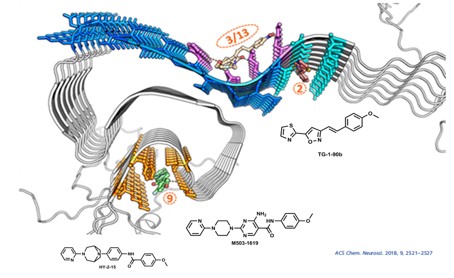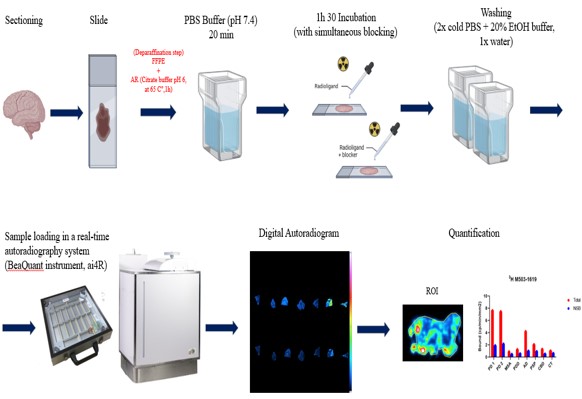Objective: To characterize the in vitro binding properties of 3 radioligands for imaging α-syn aggregates in post mortem brain samples of synucleinopathies: [3H]TG-190B (Site 2), [3H]HY-2-15 (Site 9), and [3H]M503-1619 (Site 9).
Background: The accumulation of aggregated α-synuclein is a pathological hallmark of Parkinson´s disease (PD) and other synucleinopathies, such as dementia with Lewy bodies and multiple system atrophy (MSA). The ability to image α-synuclein deposition in the brain would be key for the diagnosis of synucleinopathies, to monitor the disease progression over time, and to facilitate the development of novel treatments.
Method: We applied [3H]Tg1-90B (Site 2), [3H]M503-1619 (Site 9) and [3H]HY-2-15 (Site 9) in vitro real-time autoradiography and immunohistochemistry studies to postmortem samples from patients with a definite pathological diagnosis of Parkinson disease, Parkinson’s disease with dementia, dementia with Lewy Bodies, Multiple system atrophy and elderly controls free of pathologic changes of neurodegenerative disease. Brain tissue sections were stained for a-syn, Aβ, tau and compared to [3H]Tg1-90B, [3H]M503-1619 and [3H]HY-2-15 autoradiography on adjacent sections.
Results: Our data indicate that [3H]Tg1-90B displayed specific binding in PD, DLB and MSA tissue. [3H]M503-1619 binds to a-syn inclusions found in PD, DLB brain but not in MSA; conversely [3H]HY-2-15 autoradiography showed the opposite pattern.
Conclusion: Our observations derived from combined autoradiography and immunohistochemistry, indicate that the Site 2 ligand Tg1-90B is able to detect α-syn inclusions present both in PD and MSA patient. M503-1619 preferentially recognize α-syn aggregates in PD, PDD and DLB brain tissue over α-syn lesions in MSA patients. In contrast, HY-215 autoradiography support its potential use for imaging α-syn in MSA patients. Our results suggest that compounds targeting Site 2 ligands may be a “pan-a-syn” radiotracer (i.e., targeting both PD and MSA), whereas radiotracers targeting Site 9 show specificity for PD or MSA. The reason for the disease specificity of Site 9 ligands is not clear at this time.
Note: this abstract has been already presented at the AD/PD Alzheimer’s and Parkinson’s diseases Conference, (March 5-9 2024, Lisbon, Portugal).
Background/Objective
Experimental procedure
[3H] M503-1619 in vitro real time autoradiography
[3H] HY-2-15 in vitro real time autoradiography
[3H] TG-1-90B in vitro real time autoradiography
To cite this abstract in AMA style:
D. Saturnino Guarino, G. Tian, K. Ho Young, H. Cj, V. Lee, K. Luk, R. Mach. Autoradiography characterization of novel alpha-synuclein radioligands [3H]Tg1-90B, [3H]M503-1619 and [3H]HY-2-15 in human post mortem brain [abstract]. Mov Disord. 2024; 39 (suppl 1). https://www.mdsabstracts.org/abstract/autoradiography-characterization-of-novel-alpha-synuclein-radioligands-3htg1-90b-3hm503-1619-and-3hhy-2-15-in-human-post-mortem-brain/. Accessed December 24, 2025.« Back to 2024 International Congress
MDS Abstracts - https://www.mdsabstracts.org/abstract/autoradiography-characterization-of-novel-alpha-synuclein-radioligands-3htg1-90b-3hm503-1619-and-3hhy-2-15-in-human-post-mortem-brain/



![[3H] M503-1619 in vitro real time autoradiography](https://www.mdsabstracts.org/wp-content/uploads/2024/09/0863_1287_001436_3.jpg)
![[3H] HY-2-15 in vitro real time autoradiography](https://www.mdsabstracts.org/wp-content/uploads/2024/09/0863_1287_001436_4.jpg)
![[3H] TG-1-90B in vitro real time autoradiography](https://www.mdsabstracts.org/wp-content/uploads/2024/09/0863_1287_001436_5.jpg)